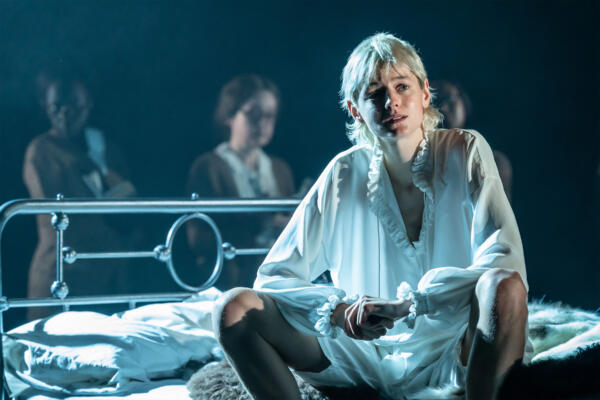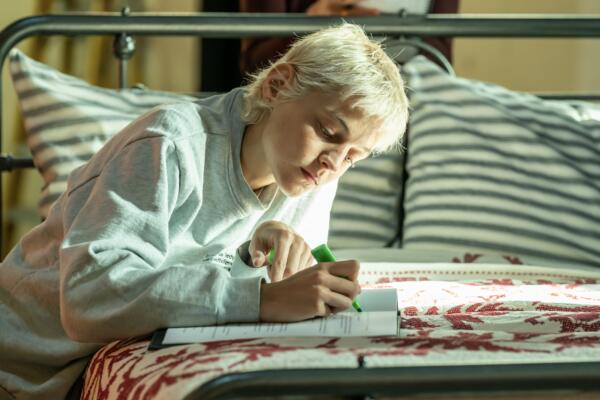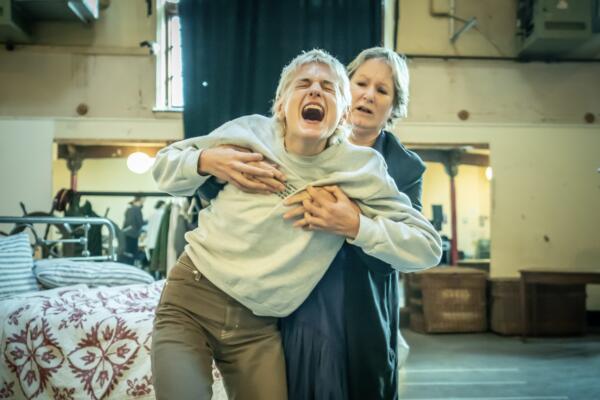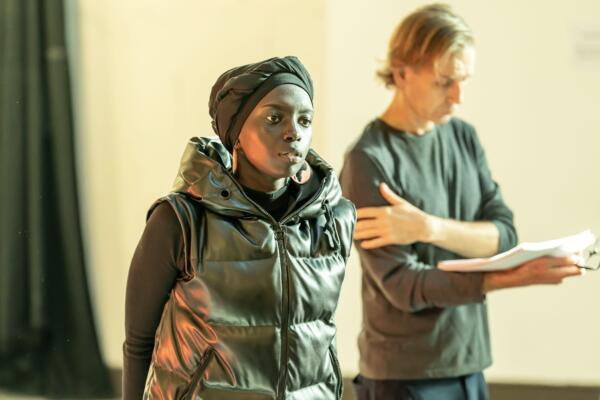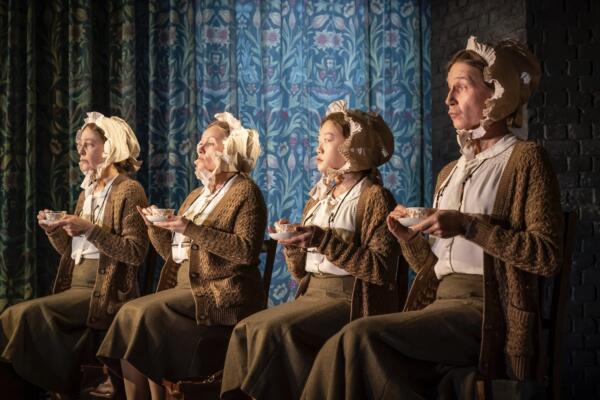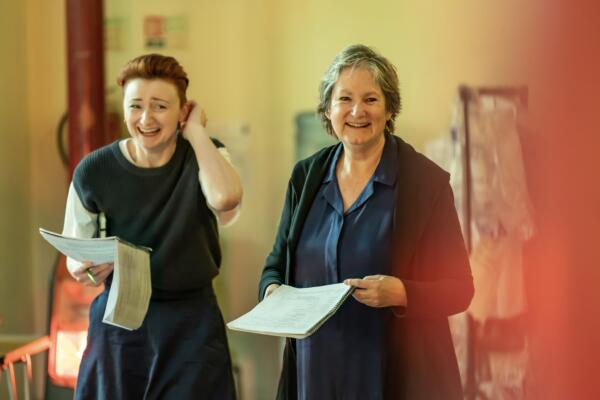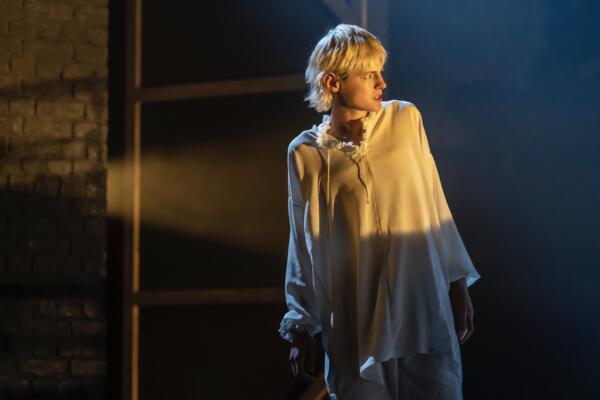Hughie | Rehearsal Diary
Hughie– Week One
Associate Director Timothy Koch provides a week‑by‑week summary of rehearsals for Hughie
It’s January 2016 and rehearsals began today for the Broadway revival of Eugene O’Neill’s epic one-act masterpiece, Hughie. We gather in the upper floor of a rehearsal studio in midtown, New York City, just off Times Square. It’s a fitting location to explore this play: O’Neill was born in a hotel just around the corner, at 43rd Street and Broadway, in the 1880s and the setting of our play is the lobby of one of the many hotels that adorned the Broadway area in the early twentieth century and, for our purposes, the year 1928.
The room is abuzz as we set out on our journey. Gathered are: our two actors, Forest Whitaker, playing Erie Smith, and Frank Wood, playing Charlie Hughes, the Night Clerk; understudy, Peter Bradbury; our director, Michael Grandage; our Voice and Speech Coach, Kate Wilson; our Stage Managers, Peter Wolf, Lisa Buxbaum and Megan Sprowls; and me, Timothy Koch, the Associate Director.
I’ve worked for Michael on three previous productions: Red, Peter and Alice and The Cripple of Inishmaan – three plays written in the last twenty years. This will be my first venture with him into working on a mid-century classic, and an American classic at that. I’m excited to see how his process applies to the peculiarities of O’Neill’s play.
Michael is generally averse to table work. He feels that any conversation we might have sitting down is more fruitful and productive once the actors are off-book and on their feet rehearsing the scene. There’s always an exception to the rule, however, and Michael recognises the individual needs of each unique play. O’Neill has written the dialogue of Hughie using slang, jargon and references that filled the streets of jazz age New York. To truly begin the rehearsal process, it’s necessary to sit down and go through the play line-by-line, making sure we all know exactly what we’re saying.
Some of the terms that warrant this table work: Bangtails, call the turn, C‑notes, fins, sawbucks, dolls, frails, Brooklyn Boys, on‑the‑lam, lousy‑with‑jack, made‑the‑break, moniker, racket, raw, rubbed out, run‑out‑powder, shut eye, small fry, sored up, square shake, on the spot, take‑to‑the‑cleaners, turtles, Wise‑Guy, sporting blood and square shake.
Although it’s English, it feels like a different language. It’s the slang you hear in Damon Runyon novels or Boardwalk Empire. My part in the process, as Associate Director, begins weeks before rehearsals as I pour over the script, looking up definitions, origins and usage for all of these words. The greatest resource for this, beyond compare, is the Oxford English Dictionary. It’s entirely thorough and full of etymological, historical and cultural context that illuminates the words of this world unlike anything else. (Many major libraries have a partnership with the OED online. Check if yours does!)
Michael begins by setting the tone for this work session: ‘There are no stupid questions.’ And even more to the point – ‘I’m going to ask a lot of stupid questions!’ He makes everyone feel comfortable to ask the meaning of what may seem like an obvious phrase or saying. This attitude encourages us to discuss words and meanings that we may know, but which we may all have a slightly different understanding of. Emerging from this process we achieve a common clarity to the language of Hughie, in addition to a well-rounded sense of the historical and cultural setting of the play.
After table work, we move right into staging. Hughie takes place in a hotel lobby and Christopher Oram, our Set and Costume Designer, has created a beautiful space in which to tell this story. Many productions place the Night Clerk’s desk, behind which the Night Clerk remains for the duration of the play, directly up centre-stage. Michael and Christopher have avoided this standard staging by placing the clerk’s desk on an angle off to stage‑right. This creates a vast, open expanse for the lobby centre‑stage. Michael and Christopher deem this Erie Smith’s ‘arena’. From this vantage point he can really take the stage and deliver the heaps of text, tales and drama over the course of the play.
A rough mock-up of the set has been constructed for the rehearsal room using chairs, plywood and the like. Before we start staging, Michael and Forest walk through the playing space with Michael pointing out the different areas that may be of use at some point: a chair near the broken elevator, a water cooler upstage right, the first few steps of the grand staircase, a long bench forlornly downstage left. Michael doesn’t dictate where in the play Forest should use these spaces, nor even that he need use them at all. Instead, Michael uses this moment to introduce the wealth of possibilities available. Forest has an open ground and free reign with which to explore the play.
Michael describes the first pass at staging the play as ‘sketching’. Just as an artist would draw with pencil and paper before attempting a grand painting, we too are merely sketching the outline of what will someday be fully realised. This allows a low‑pressure freedom to permeate this week. Rather than being results‑oriented, the process is focused on the light shape of things. Forest and Michael therefore try his first entrance and subsequent crosses maybe a dozen different ways, until the sketched lines start to grow darker and the clearest and most natural choice becomes more boldly marked.
Michael’s idea of ‘sketching’ melds nicely with Forest’s approach to building character. Early on he asks for bits of paper and other detritus that may be in the pockets of a down‑on‑his‑luck gambler. O’Neill’s text never specifically mentions these elements, but Forest has a hunch that they will prove useful in getting into character and motivating the action. Within the first few days this proves true: old betting slips motivate a cross to the bench, where he works to sort them out, thus helping Erie get his bearings before launching into another story for his new audience, Charlie. In a beat of despairing loneliness, Forest fishes out a half-smoked cigar and attempts to light it. Erie’s lighter is out of fuel and after repeated attempts he gives up on this last respite, defeated in full. These bits of action will evolve and refine themselves over the rehearsal process and it’s the nature of ‘sketching’ in the first week that sets the tone for that exploration.
Hughie is by no means a long play. Compared with O’Neill’s more notable, hefty works, Hughie is a brief drama with a run time of approximately one hour. Within this hour, though, Michael emphasises that we find all the highs and lows, tragedies and laughter of any four or five-act drama. With the shorter run time there is the tendency to go quickly, running through the play by the second or third day or rehearsal. Michael resists this, emphasising to Forest and Frank that they should go slowly. We intentionally stop and start and repeatedly run even just a page or half a page of text. We do not even attempt a full run through in this first week. Each day we begin where we left off the day before – the middle, the ending, the beginning sometimes – and we continue from there, moving slowly. Anytime we start to gain momentum, Michael will stop the actors with a note or adjustment. In one instance, after Forest finishes one of Erie’s longest speeches in the play, Michael says simply: ‘That was good. Let’s do it again.’ We work in these smaller beats, plumbing the depths of the play and refining the blocking for the rest of the week.
